Exploring Types of Optical Fibers: Characteristics and Uses
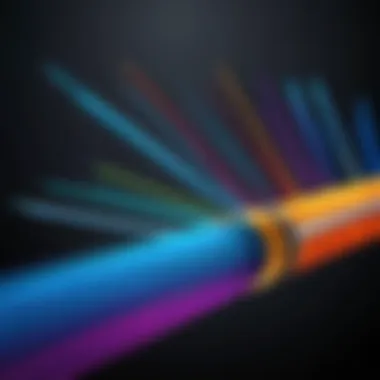
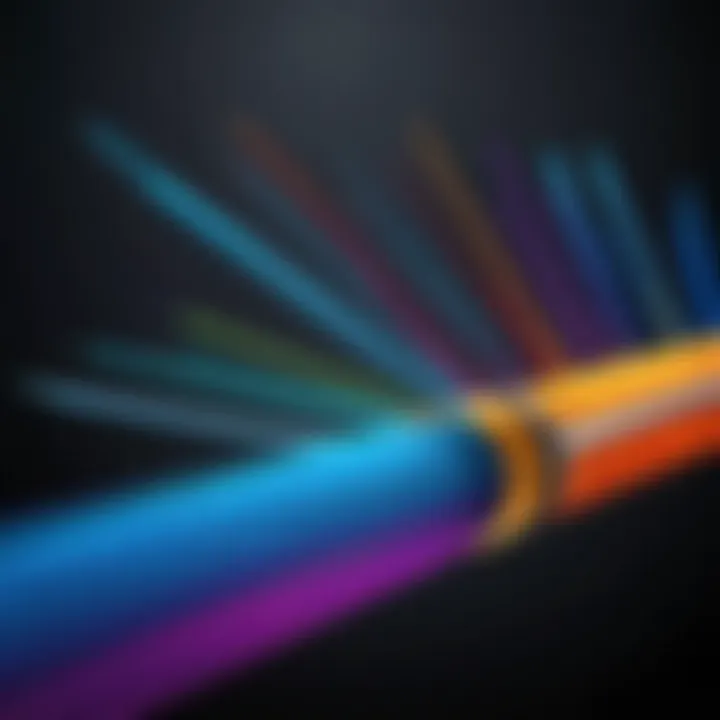
Intro
When we dive into the world of optical fibers, what really strikes us is how crucial they have become in the modern communication landscape. The advancement in technology and the constant demand for faster data transmission have surely thrown optical fibers into the limelight. Unlike traditional copper wires, optical fibers, with their ability to transmit data over long distances at high speeds, form the backbone of today’s connectivity, be it in our homes or sprawling enterprise networks.
But what exactly distinguishes one type of optical fiber from another? Is it merely the way they look or is there more under the hood? Understanding these nuances is essential not just for IT professionals but for anyone working in or studying networking technologies. In this article, we will unfold the layers of optical fiber types, emphasizing their unique characteristics, applications, and how they serve various networking scenarios.
To kick things off effectively, let's take a closer look at
Understanding Storage, Security, or Networking Concepts
Intro to the basics of storage, security, or networking
First and foremost, understanding optical fibers inherently connects with grasping broader concepts within networking. These fibers act like the highways for data, facilitating its movement across networks swiftly and efficiently. The essence of networking lies in transmitting information from one point to another. Whether it's a simple email or a massive data transfer, optical fibers do the job better than many alternatives.
Key terminology and definitions in the field
- Optical Fiber: A flexible, transparent fiber made of glass or plastic, used to transmit light.
- Multimode Fiber (MMF): A type of optical fiber that allows multiple light modes or rays to propagate through it, typically used for shorter distances.
- Single-mode Fiber (SMF): A type of optical fiber that supports one light mode, allowing for longer distances with a reduced rate of signal loss.
Overview of important concepts and technologies
As we sift through the different types of optical fibers, it becomes crucial to understand how light transmission takes place. This involves knowledge of different light propagation modes, refractive index, and the photonic interactions that dictate performance. The differences between multimode and single-mode fibers lie in every facet, from their structure to their application scope, making them vital for specialized tasks.
"Understanding the integral role of optical fibers is pivotal in optimizing modern telecommunications."
Having laid the groundwork, let's venture into more detailed sections to break down the specifics and intricacies that define optical fiber types.
Prelude to Optical Fiber
Optical fiber technology has transformed the way we communicate and transport data. Understanding optical fibers is crucial for IT professionals, cybersecurity experts, and students alike, as they play an indispensable role in modern telecommunications. The capacity of fibers to carry vast amounts of information over long distances with minimal loss makes them the backbone of internet infrastructure, smart cities, and beyond.
The significance of optical fibers lies not only in their efficiency but also in their versatility. They are increasingly adopted for various applications, ranging from data centers to medical instruments. By exploring the different types of optical fibers, their characteristics, and their tailored applications, readers gain a clearer picture of how to harness this technology effectively.
Definition of Optical Fiber
Optical fiber is a thin, flexible strand made of glass or plastic that transmits light signals. These fibers work on the principle of total internal reflection, where light bounces off the core walls they are encased in, allowing for the transmission of information over long distances. The core and cladding of optical fiber have varying refractive indices, which facilitate this light travel without significant loss.
The composition of optical fibers varies, leading to different types, each with its unique traits. This diversity caters to a broad spectrum of applications, from high-speed internet connections to intricate medical devices.
History and Development
The journey of optical fiber technology dates back to the early 19th century, notably marked by the works of scientists like Daniel Colladon and Jacques Babinet, who demonstrated that light could be guided through water.
As technology progressed, researchers like Harold Stephen Black and Thomas Edison contributed to refining the methods for transmitting light signals through glass. However, it wasn't until the 1970s that significant advancements were made, with the introduction of low-loss glass fibers. This made practical long-distance communications feasible.
The late 20th century saw the commercial rollout of fiber optic technology, fueled by the growing demand for high-speed communication systems. Companies like AT&T and Corning Glass Works began exploring its potential for telecommunications.
Today, optical fibers are at the forefront of global communication, underpinning high-speed networks and fostering innovations in various fields. As technology continues to evolve, the development of new types of fibers and applications remains on the horizon, promising an even brighter future for this incredible medium.
Categories of Optical Fiber
Optical fibers have changed how we communicate and transmit data, making them a backbone of modern technology. Understanging the categories of optical fiber is vital for IT professionals and anyone interested in networking. They fall mainly into two groups: multimode and single-mode fibers. Knowing the differences between these types helps in making informed decisions about their use in various applications, whether it’s a local area network or long-distance communication. Each category has its own set of characteristics, benefits, and considerations that make it suited for different scenarios.
Multimode Fiber
Multimode fiber is characterized by its larger core diameter, typically around 50 to 62.5 micrometers. This size allows different modes of light to travel through the fiber simultaneously. Because of this, multimode fibers are commonly used for short-distance communications. They are particularly efficient in environments where data needs to be transmitted over a distance of up to 2 kilometers, like within a building or a campus.
One of the standout features of multimode fibers is their cost-effectiveness. Installation costs can be lower compared to single-mode fibers since the components used, such as light sources, are generally less expensive. Plus, it's easier to work with them during the installation process because alignment of the fiber optical connectors can be less stringent.
However, it’s crucial to consider their limitations. The main downside is related to signal attenuation. As multiple light modes bounce within the fiber core, they can interfere with each other, leading to degraded signal quality at longer distances. For those looking to make a choice, it's key to keep in mind that while multimode fibers might be the go-to for shorter runs, their performance can diminish when it comes to long-distance applications.
Single-Mode Fiber
On the other side of the spectrum, we have single-mode fiber, which features a much smaller core diameter of about 8 to 10 micrometers. This design allows only one mode of light to propagate, which significantly enhances transmission quality over long distances. This makes single-mode fiber the preferred choice for telecommunications and internet connections between cities and high-capacity data networks.
The performance advantage is immediately apparent. With less modal dispersion - the phenomenon causing light signals to spread out and overlap - single-mode fibers can successfully transmit signals over distances of over 80 kilometers without a significant loss in quality.
Investing in single-mode fiber might come with a higher initial cost for both the cables themselves and the required higher-quality laser light sources. Nevertheless, the signal integrity and capacity for higher data rates often justify this investment in the long run. When every millisecond matters, single-mode fiber stands out.
In summary, as we explore the categories of optical fibers, we realize that choosing the right fiber involves weighing the benefits of cost against performance needs. By understanding how multimode and single-mode fibers serve differing functions, we can ensure that data transmission remains robust and efficient in various environments.
Multimode Fiber Explained
Understanding multimode fiber is crucial for anyone delving into the world of optical communications. This type of fiber is aptly named because it allows multiple light modes to propagate through its core simultaneously. This characteristic stands central to its operational nature and applications, particularly in environments where cost efficiency and ease of setup are priorities. Let’s break down the intricacies involved in this fiber type into specific elements—its core structure, light propagation mechanics, and loss characteristics—to get a clearer picture of why multimode fiber is often chosen for networking tasks.


Core Structure
The core of multimode fiber is relatively large compared to its single-mode counterpart. Typically, the core diameter can range from 50 to 62.5 micrometers, allowing the light to bounce off the inner walls of the fiber. This bouncing is key to how the fiber operates, supporting various light paths that travel at different speeds.
A fundamental aspect of the core structure is its design:
- Step-Index Multimode Fiber: This design features a uniform refractive index in the core followed by a sharp change in refractive index at the cladding. The abrupt transition allows for distinct reflections.
- Graded-Index Multimode Fiber: This type modifies the refractive index from the center of the core outwards, creating a gradient that reduces modal dispersion. Light travels through the core more smoothly, working to minimize distortion across signals.
Light Propagation
Light propagation in multimode fiber operates on the principle of multiple paths. When pulses of light enter the core, they can take several routes to reach the end. Each type of light path behaves differently due to variations in reflection angles and speed. The benefits of this multiple-path approach are clear:
- Increased Light Capture: Given the larger core size, more light can enter the fiber, which enhances transmission capacity.
- Simplicity in Installation: The forgiving nature of multimode fiber generally makes it easier to align connections, leading to less stringent installation criteria.
However, there's a flip side:
- Modal Dispersion: Over long distances, different paths can cause signals to arrive at varying times, leading to potential data loss or distortion.
Loss Characteristics
Understanding loss in multimode fiber is about analyzing two primary categories: attenuation and modal dispersion.
- Attenuation: This refers to the loss of signal strength as it travels along the fiber. While multimode fibers are generally known for lower attenuation rates compared to copper wire, the quality of the core material and installation imperfections can still lead to increased loss.
- Modal Dispersion: As mentioned earlier, this is a significant player in signal integrity. Because light travels through different paths, it can lead to distortions especially in high-speed applications. Correctly managing the fiber length and maintaining proper installation standards becomes essential to minimize these losses.
Culmination of Section
In summary, understanding the characteristics of multimode fiber—its core structure, light propagation specifics, and loss characteristics—provides IT professionals and researchers insights that guide decisions on networking technologies. While multimode fiber offers considerable benefits for short-distance transmission, it requires meticulous attention to its limitations in applications demanding high precision and efficiency.
Single-Mode Fiber Explained
Single-mode fiber plays a pivotal role in modern telecommunications. Its design and application streamline long-distance data transmission, making it essential for high-speed networks. This section elucidates the core dimensions, light transmission properties, and methods to minimize signal loss associated with single-mode fibers.
Core Dimensions
The structure of single-mode fiber is characterized predominantly by its small core diameter. Typically, this diameter ranges around 8 to 10 micrometers. The thin core effectively allows only one mode of light to propagate, hence the name single-mode. This limitation of modes reminisces the simplicity of a needle threading through a vast field; only one thread can weave its path clearly through the landscape.
Because of this design, single-mode fibers are able to maintain strong signal integrity over long distances. The smaller core reflects light directly back toward the center, thus minimizing loss caused by dispersion.
Light Transmission
Single-mode fibers are adept at transmitting light over extensive distances, crucial for backbone connections in network infrastructures. The way light travels within the fiber is essential for understanding its effectiveness. In single-mode fibers, light travels in a straight line, without bouncing around as in multimode fibers. This linear pathway reduces modal dispersion, which contributes to clearer and more precise data transmission.
The properties of attenuation also come into play; single-mode fibers tend to have lower attenuation rates compared to multimode fibers. The technical benefit here is substantial: a clear signal can traverse hundreds of kilometers without significant degradation. Therefore, for long-hop networks, single-mode becomes the golden choice.
Minimizing Signal Loss
Minimizing signal loss in single-mode fiber involves a couple strategic and technical aspects. First, the use of high-quality materials during manufacturing greatly affects performance. For instance, fiber made with silica glass is often preferred due to its lower scattering losses.
"The right materials pave the way for optimal performance, ensuring that light remains as unscathed as possible during its journey."
Proper installation procedures also play a significant role. For example, ensuring the fiber is not bent too sharply prevents additional losses due to micro-bending. Additionally, regular maintenance checks and proper connector compatibility can yield significant improvements in signal retention.
In summary, single-mode fiber’s structure and characteristics make it indispensable for high-capacity, long-distance communication. By understanding core dimensions, light transmission mechanics, and loss minimization strategies, professionals can better appreciate and leverage the capabilities of single-mode optical fibers effectively.
Comparison Between Multimode and Single-Mode Fibers
Understanding the differences between multimode and single-mode fibers is crucial for anyone involved in networking and telecommunications. While both are designed to transmit data via light, they serve different purposes and are optimized for distinct applications. This section will dissect the various attributes of these fiber types, focusing on transmission distance, data rates and bandwidth, and cost considerations—elements that significantly influence design and deployment decisions.
Transmission Distance
The transmission distance is a principal factor when comparing multimode and single-mode fibers.
- Multimode fibers typically support short-range communication. Their core diameter, larger than that of single-mode fibers, enables multiple light modes to propagate, which, while offering an initial advantage, induces modal dispersion. This broadening of the light signal can limit effective transmission over long distances, putting multimode at about 300 meters to 2 kilometers in practical cable lengths typically used in data centers and local area networks.
- On the other hand, single-mode fibers are engineered for long-distance applications. With a much smaller core diameter, these fibers allow only one light mode to pass through, minimizing modal dispersion and allowing for distances that can exceed 40 kilometers or more. In situations where high transmission distances are necessary, such as in metropolitan area networks or long-haul communications, single-mode fibers often reign supreme.
"The choice of fiber type directly affects network performance and can either hamper or enhance data transmission, depending on the distances involved."
Data Rates and Bandwidth
When considering the throughput capabilities of these fiber types, the data rates and bandwidth potential can also diverge significantly.
- Multimode fibers, while capable of supporting high data rates, usually find their limitations becoming apparent as the distance increases. In most commercial multimode systems, bandwidth is theoretically sufficient to support data rates from 1 Gbps up to 100 Gbps, depending on the technology and conditions. However, effective rates tend to decrease over longer runs due to increased signal deterioration.
- In contrast, Single-mode fibers are often regarded as the champions in bandwidth capacity. Capable of supporting data rates well above 100 Gbps, single-mode fibers can enable high-performance applications including dense wavelength division multiplexing (DWDM), which maximizes the data carrying capacity per fiber strand. Their ability to maintain signal integrity over long distances further enhances their suitability for bandwidth-intensive applications.
Cost Considerations
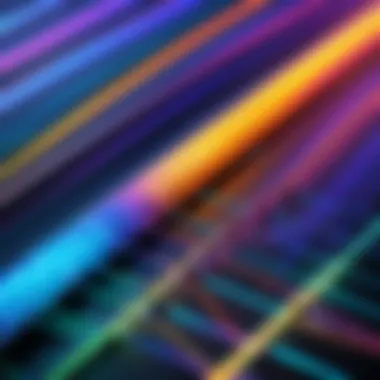

While performance metrics may lean towards one fiber type over another, cost is often the deciding factor in technology acquisition and deployment.
- Multimode fibers tend to be more affordable to install due to their generally lower costs for fiber and connectors. The associated equipment, such as multimode transceivers, also tends to be less expensive than single-mode counterparts. Consequently, for organizations focused on cost, short-range applications with multimode optical fibers can be appealing, particularly in environments where long cable runs are unnecessary.
- Conversely, single-mode fibers bear a higher initial cost. The fiber itself, connectors, and requisite components necessary for long-distance transmissions come with a price premium. However, organizations often regard this as a worthy investment given the capacity for longer transmission distances and lower total cost of ownership in situations where expanded bandwidth and lower maintenance are crucial over time.
Applications of Optical Fibers
The role of optical fibers in modern technology can’t be overstated. These slender strands bundle enormous potential, functioning as the backbone for countless applications across various industries. The remarkable capabilities of optical fibers enable faster, more reliable communication and data transfer, transcending the limitations of traditional copper wiring. From telecommunication networks that connect millions to advanced sensor technologies, optical fibers prove to be essential tools driving innovation. Let's delve deeper into the distinct applications that highlight the importance of optical fibers.
Telecommunication Networks
In the realm of telecommunication, optical fibers revolutionize the way information is transmitted. The typical copper cables reach their limit in terms of bandwidth and distance, but optical fibers break those barriers. Here are a few considerations that underline their significance in this field:
- High Capacity: Optical fibers can carry vastly more data than copper cables, allowing networks to support an ever-growing demand for data traffic.
- Speed: Light pulses travel through fiber at speeds nearing that of light in vacuum, making it possible for near-instantaneous communication over long distances.
- Signal Integrity: With minimal signal loss and interference, optical fibers maintain data quality, which is particularly important for voice, video, and high-speed internet.
In summary, the superior performance of optical fibers makes them essential for telecommunication infrastructures, ensuring connectivity and efficiency in our increasingly digital world.
"Optical fiber technology enables telecommunications service providers to offer higher speeds, better reliability, and increased bandwidth."
Data Centers
Data centers are like the heart of the internet, processing and storing vast volumes of information. Here, optical fibers serve a pivotal function, effectively linking servers and facilitating high-speed data exchange. Consider these points when discussing their relevance in data centers:
- Efficient Space Utilization: Optical fibers are thin and lightweight, allowing for denser arrangements of cabling compared to traditional methods, saving crucial space in data center layouts.
- Scalability: As data demands surge, optical fibers can be installed or upgraded to handle increased loads without significant overhauls, providing a scalable solution.
- Low Power Consumption: They consume less power than copper cables during data transmission, contributing to energy efficiency, which has become a major concern for many companies today.
By leveraging optical fibers, data centers enhance their capabilities, ensuring that they can manage high volumes of data seamlessly and securely.
Sensor Technology
Beyond the traditional communications horizon, optical fibers find applications in sensor technology, offering unique solutions for various fields such as healthcare, environmental monitoring, and industrial automation. Here's how they contribute:
- Sensitivity: Optical fibers can detect minimal changes in temperature, pressure, or strain, making them valuable in fields requiring precise measurements.
- Remote Monitoring: They allow for remote sensing in harsh environments, transmitting data from places where traditional sensors may fail.
- Multiplexing Capability: Multiple sensors can be integrated into a single fiber, allowing for the monitoring of various parameters in real time without adding significant bulk.
In the dynamic field of sensor technology, optical fibers are crucial in developing smart sensors that enhance efficiency, safety, and analysis capabilities.
In summary, the breadth of applications for optical fibers showcases not just their versatility, but also their fundamental role in advancing technologies that require reliable and efficient data transmission. Their importance spans critical sectors, highlighting the need to understand their functionalities and potential.
Types of Multimode Fibers
The realm of optical fibers is vast, but when we focus on multimode fibers, we open a door to understanding networking that is both complex and crucial. Multimode fibers are particularly vital for data transmission over short distances, playing an essential role in various applications, from telecommunication to medical imaging. This section dives into two primary categories of multimode fibers that exhibit distinct characteristics and performance metrics, allowing professionals to make informed choices tailored to their specific needs.
Step-Index Multimode Fiber
Step-index multimode fiber is perhaps the most straightforward type of fiber in terms of design. Its core has a uniform refractive index, which changes abruptly at the cladding. This sharp transition creates a sort of "step" that guides the light significantly along the length of the fiber.
The benefits of this type include:
- Simplicity in design: Easier to manufacture and thus typically more cost-effective.
- Versatility: Ideal for short-distance applications, like within a building or campus setup.
However, it does come with certain constraints. The sharp boundaries at the core-cladding interface lead to modal dispersion, which can limit the bandwidth in longer runs. This means that while you can transmit data over shorter distances without a hitch, the quality can suffer if you attempt longer spans.
"The step-index structure allows rapid propagation, but be mindful of the distances involved to avoid potential pitfalls in signal quality."
Graded-Index Multimode Fiber
In contrast to step-index multimode fibers, graded-index multimode fibers are engineered with a core that has a gradient in its refractive index. This unique feature allows light rays to bend gradually as they travel through the fiber, reducing modal dispersion and enabling higher performance over greater distances.
The benefits are significant:
- Enhanced bandwidth: The gradual curve of light minimizes signal degradation, allowing for faster data transmission.
- Longer distances: You can reliably transmit over longer distances compared to step-index fibers, making it appealing for more extensive networks.
This type, while more complex in design, is often favored in environments demanding high performance, such as data centers or large telecommunication networks.
Types of Single-Mode Fibers
Understanding the varieties of single-mode fibers is crucial for professionals and students alike who look to harness the power of optical technology. These fibers are designed for long-distance communication, allowing for minimal signal degradation and high bandwidth capabilities. The sharp focus on how different types of single-mode fibers operate and where they can be applied enriches one's knowledge about networking and data transmission.
Standard Single-Mode Fiber
Standard single-mode fiber, typically just referred to as SMF, has a core diameter of about 8 to 10 micrometers. This slim core enables only one mode of light to propagate, which helps in reducing modal dispersion. Essentially, this means a clearer signal over longer distances. The development of standard single-mode fibers has allowed various industries to establish high-speed communication channels without interference that could cause data loss.
The performance of standard single-mode fiber is heavily influenced by its wavelength. Commonly, the fibers are optimized for signals in the 1310 nm and 1550 nm ranges. The 1550 nm wavelength, in particular, is one of the most utilized because it has lower attenuation, which means the light can travel further without losing its strength.
This type of fiber finds extensive applications in telecommunication networks, especially in backbone connections that link central offices and data centers. Some benefits of standard single-mode fibers include:
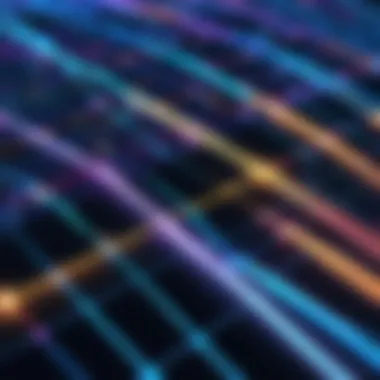
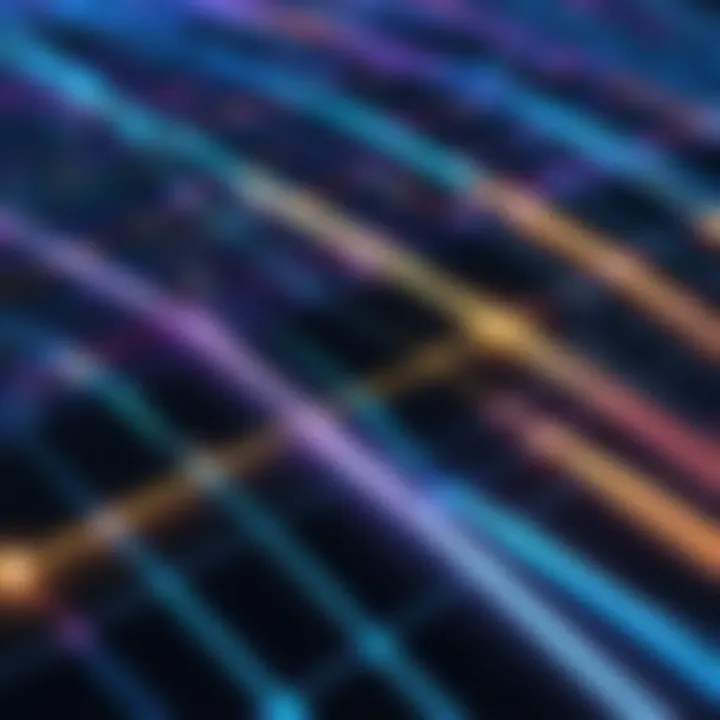
- Long Transmission Distances: Capable of transmitting signals for several kilometers without significant loss.
- High Bandwidth: Supports high data rates suitable for modern-day requirements.
- Reduced Interference: Offers better performance in environments with electromagnetic interference.
In summary, standard single-mode fibers serve as the backbone of modern telecommunication, ensuring efficient and reliable data transmission across vast distances.
Reduced-Mode Fiber
Reduced-mode fiber represents an innovative twist on the traditional single-mode design. It typically has a slightly larger core diameter than standard single-mode fibers, yet still maintains the ability to have lower losses while supporting fewer modes of light transmission.
One of the standout features of reduced-mode fiber is its enhanced performance characteristics. By manipulating the refractive index profile, manufacturers can achieve various design goals, including reduced dispersion and improved signal integrity over distance. This design is particularly valuable in areas where long-distance connectivity is essential but standard single-mode might incur inefficiencies due to environmental factors or infrastructure limitations.
Moreover, the flexibility in core size allows reduced-mode fibers to support a variety of applications, such as:
- Telecom Backbone: Like standard fibers, these are used in telecom to connect regional networks.
- Research Facilities: They can enable high-precision experiments that require minimal signal degradation.
- Hybrid Systems: Reduce-mode fibers can be combined with multimode fibers for specialized networking configurations.
Fiber Optic Connectors and Their Importance
Fiber optic connectors may not steal the spotlight in fiber optic technology discussions, but they are crucial components that greatly influence performance and reliability in data transmission. These connectors act as bridges, ensuring that the light signals traveling through the fibers are transmitted efficiently from one fiber to another or from fiber to various networking devices. Without proper connectors, even the best fiber optic cables cannot perform at their best.
The importance of fiber optic connectors is underscored by their role in minimizing signal loss and ensuring effective connectivity. Unlike copper cables, where the signals travel through electrical pathways, fiber optics relies on light. Any misalignment in the connectors can lead to a black hole for signals, resulting in wasted resources and degraded performance.
Moreover, the connectors are engineered differently to adapt to varying network demands, both in scale and application. For instance, a small data center may not require the same rugged network build as a sprawling telecommunications installation. Therefore, choosing the right connectors can lead to significant enhancements in transmission fidelity, ultimately improving overall system performance.
"A perfect connection can be the difference between seamless communication and frustrating dropouts."
In summary, fiber optic connectors are vital in optimizing the capabilities of fiber optic systems. They not only facilitate effective communications across vast networks but also help in achieving cost-effectiveness in deployment by reducing maintenance incidents related to signal issues.
Types of Connectors
Understanding the varieties of fiber optic connectors can be pretty enlightening, especially for those involved in networking or IT professions. Below are some of the most common types:
- SC Connector: Often referred to as the Subscriber Connector, it employs a push-pull mechanism, making installation and removal quick and easy. It's prevalent in data communication networks.
- LC Connector: The Lucent Connector is compact, often found in high-density applications. Its design allows for efficient space management.
- ST Connector: This connector features a bayonet-style coupling mechanism, which ensures a secure and reliable connection. It's commonly used in legacy systems, especially in multimode applications.
- MTP/MPO Connector: These multi-fiber connectors streamline the process of connecting multiple fibers at once, ideal for applications requiring high-density connections.
Choosing the right connector can impact several factors, including space utilization, ease of installation, and overall network efficiency. Each connector type brings its unique benefits and is tailored for specific applications and environments.
Choosing the Right Connector
Navigating the labyrinth of fiber optic connectors can feel daunting, but understanding specific requirements can simplify the process. When opting for the right connector for a project, consider the following factors:
- Application Needs: What is the intended use? Whether it’s for telecom, data centers, or sensor applications can dictate connector choice.
- Connector Compatibility: Ensure that the selected connector is compatible with the existing equipment and infrastructure. Mismatched connectors can lead to expensive adjustments.
- Environmental Factors: If the installation site is subject to extreme conditions, such as moisture or dust, then robust connectors might be necessary.
- Ease of Use: Certain connectors, like the LC or SC, offer features that make them easier to handle during installation and maintenance compared to others.
- Budget Limitations: Cost is always a consideration. Assess the trade-off between quality and cost-effectiveness in conjunction with long-term performance expectations.
Selecting a connector should not be merely procedural but strategic, aligning with both immediate needs and future scalability. Proper planning can ensure the longevity and efficiency of fiber optical systems.
Future Trends in Optical Fiber Technology
The realm of optical fiber technology is always on the move, pushing boundaries and finding its way into new corners of everyday life. As we peer into the future, several noticeable trends emerge, each promising to deepen the role of fiber optics in communication and beyond. This section digs into what’s on the horizon and why it matters for anyone involved in networking and IT solutions.
Advancements in Fiber Design
Every so often, the design of optical fibers sees a shift that leads to improved performance and capabilities. For instance, the emergence of photonic crystal fibers allows for a new level of control over light propagation. These fibers manipulate light in unique ways, enabling the transmission of light at wavelengths that traditional fibers cannot handle. This property is not only fascinating; it opens doors for more efficient data transmission, particularly in demanding environments.
Another notable advancement is in the area of polymer optical fibers. These are generally more flexible and easier to install than standard glass fibers. This adaptability makes them ideal for residential settings or small businesses that may not have extensive cabling needs but still demand reliable connectivity.
Moreover, new manufacturing techniques optimize the quality of the fiber, reducing loss and increasing performance. These innovations play a crucial role in future-proofing networks, as they support higher data rates and longer distances with less energy, a key consideration in a world where sustainability holds increasing relevance.
Emerging Applications
As optical fiber technology progresses, its applications continue to expand, reaching into diverse fields such as healthcare, entertainment, and even transportation.
- Healthcare: Use of optical fibers in medical instrumentation is growing. For example, fiber-optic sensors can monitor patients with real-time data, allowing healthcare professionals to detect changes in vital signs instantly.
- Smart Cities: Optical fibers are becoming integral to the infrastructure of smart cities. They are essential for the communication networks that interlink various smart devices, creating a seamless, connected environment.
- Augmented Reality: With the rise of augmented reality, optical fibers can provide the necessary bandwidth to create immersive user experiences without lag, bringing virtual interactions to life.
- Environmental Monitoring: Fibers serve as sensing tools in environments where traditional sensors might fail, like underwater monitoring, or in harsh industrial conditions.
"The future of optical fibers goes beyond mere communication; it is poised to revolutionize how we interact with both technology and the environment."
As we move forward, eyeing these trends keeps IT professionals and curious minds equally informed. Understanding how fiber optics can adapt and advance is crucial not only for maintaining competitive edge but also for unswervingly meeting the challenges brought on by increasing demand for connectivity and efficiency.
Closure
In wrapping up our exploration of optical fibers, it's crucial to reiterate the significance of this topic. The understanding of different optical fiber types is not merely academic; it holds substantial practical implications for IT professionals, cybersecurity experts, and students alike. Knowing the characteristics and applications of various fibers is key when making decisions regarding network designs and configurations.
Summarizing Key Points
- Categories of Optical Fibers: The article divides fibers into two main categories: multimode and single-mode. Each type has distinct features that make it suitable for specific applications.
- Structure and Performance: From the core dimensions to loss characteristics, the structural intricacies of each fiber type directly influence their performance. For instance, multimode fibers are better for short-distance communication, while single-mode fibers excel in long-distance transmission.
- Applications and Trends: The practical uses of these fibers are abundant. Whether in telecommunications, data centers, or sensor technologies, understanding application relevance helps professionals adopt the right technology. As the realm of optical fibers continues evolving, staying abreast of advancements is beneficial.
The understanding of optical fiber types is not merely an academic exercise; it is essential for informed decision-making in technology and networking applications.
Final Thoughts on Optical Fibers
To conclude, optical fibers serve as a backbone for modern communication technologies. They facilitate high-speed data transfer and enable the expanding infrastructure of the digital world. With the continuous advancements in fiber technology, it's vital for professionals in IT and related fields to be well-versed in these systems.
In light of the growing demand for faster and more secure connections, knowledge about the various types of optical fibers will remain indispensable. As we look ahead, consider how these technologies will further shape communication landscapes, and ensure you keep updated with industry trends.



